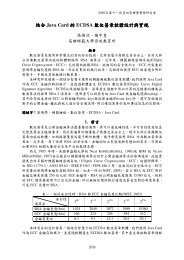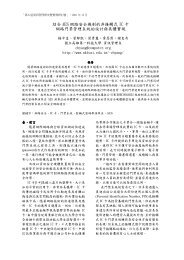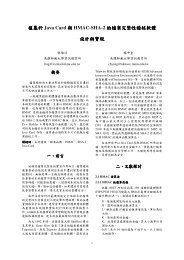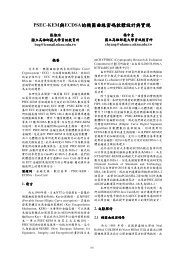aryabhata remainder theorem: relevance to public-key crypto ...
aryabhata remainder theorem: relevance to public-key crypto ...
aryabhata remainder theorem: relevance to public-key crypto ...
Create successful ePaper yourself
Turn your PDF publications into a flip-book with our unique Google optimized e-Paper software.
10 RAO AND YANG<br />
4.1. Garner’s algorithm (GA) compared with CRT<br />
Garner [3] deduced an algorithm <strong>to</strong> convert the residue code of a number X =<br />
(v1,v2,...,vt) with respect <strong>to</strong> pairwise relatively prime modulo m1, m2,...,mt<br />
<strong>to</strong> a mixed radix number with weight 1, mt, mt−1mt, and so on up <strong>to</strong> the last<br />
one m2m3 ...mt. Then its radix equivalent can be easily computed using those<br />
weights. As an example he chose (1, 2, 0, 4) for moduli set (2, 3, 5, 7) and converted<br />
<strong>to</strong> the mixed radix form of (0, 2, 3, 4) whose weights are (105, 35, 7, 1)<br />
respectively. Then X = (1, 2, 0, 4) represented 0 · 105 + 2 · 35 + 3 · 7 + 4 = 95.<br />
Arefined version of Garner’s algorithm has been given in [9] as follows.<br />
INPUT: a positive integer M = t i=1 mi, with gcd (mi, m j) = 1 for all i = j,<br />
and a modular representation v(x) = (v1,v2,...,vt) of x for the mi.<br />
OUTPUT: the integer x in radix b representation.<br />
1. For i from 2 <strong>to</strong> t do the following:<br />
Ci ← 1.<br />
For j from 1 <strong>to</strong> (i − 1) do the following:<br />
u ← m −1<br />
mod mi<br />
2. u ← v1, x ← u<br />
j<br />
Ci ← u · Ci mod mi<br />
3. For i from 2 <strong>to</strong> t do the following: u ← (vi − x) · Ci mod mi,<br />
x ← x + u · i−1<br />
j=1 m j<br />
4. Return (x).<br />
x returned by algorithm (GA) satisfies 0 ≤ x < M, x ≡ vi(mod mi), 1 ≤ i ≤ t.<br />
Example 7 Garner’s algorithm [9]. Let m1 = 5, m2 = 7, m3 = 11, m4 = 13,<br />
M = 4 i=1 mi = 5005, and v(x) = (2, 1, 3, 8). The constants Ci = computed<br />
are C2 = 3, C3 = 6, C4 = 5. The values (i, u, x) computed in Step 3 of<br />
the algorithm are (1, 2, 2), (2, 4, 22), (3, 7, 267), and (4, 5, 2192). Hence, the<br />
modular representation v(x) = (2, 1, 3, 8) corresponds <strong>to</strong> the integer X = 2192.<br />
Menezes et al. [9] provide a discussion on the computational efficiency of GA as<br />
follows:<br />
If Garner’s algorithm is used repeatedly with the same modulus M and the same<br />
fac<strong>to</strong>rs of M, then step 1 can be considered as a precomputation, requiring the<br />
s<strong>to</strong>rage of t − 1 numbers. The classical algorithm for the CRT typically requires<br />
a modular reduction with modulus M, whereas Garner’s algorithm does not.<br />
Suppose M is a kt-bit integer and each mi is a k-bit integer. A modular reduction<br />
by M takes O((kt) 2 ) bit operations. Whereas a modular reduction by mi takes<br />
O(k 2 ) bit operations. Since Garner’s algorithm only does modular reduction with
















